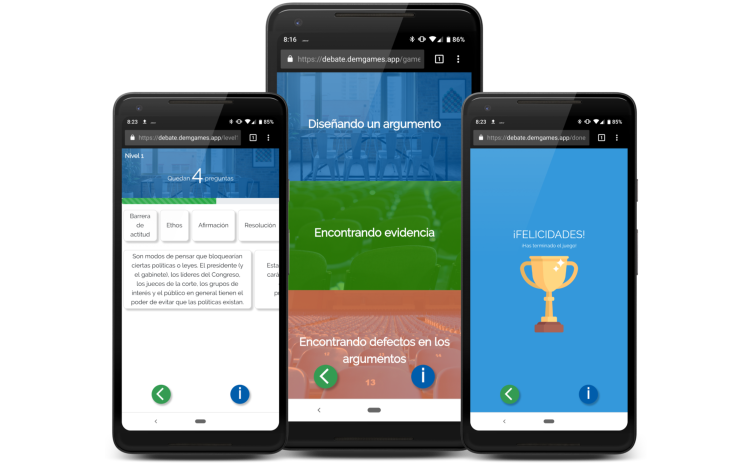Throwback Thursday: Bringing Design Sprints to NDI

As the Technology Innovation team at NDI, we are always looking for new approaches to build impactful platforms. One of our recent pilot projects—DemGames—offers our partner organizations an opportunity to engage youth on civic and voter education issues through an interactive gaming platform. As we began to think of the many ways a gaming platform could contribute to a youth debates program in Guatemala, we decided to run a three-day design sprint back in April to develop a low-fidelity prototype we could begin to test.
Over the course of these three days, we worked with our Design Sprint participants to design an impactful gaming platform intended to compliment assessment tools around civic and voter education principles for youth, focusing on scalability and fun. While we continue to iterate on our design after launching an MVP in Guatemala earlier this year, here are some of the lessons that we have learned about adapting the design sprint methodology to a non-profit organization like ours:
BYOB: Buy-in is Your Only Bet
Design Sprints are only as successful as the buy-in you have. Detailed communication and marketing strategy for the months leading up to the sprint was instrumental in helping us get buy-in from leadership and our participants to try this new approach. Design sprints are resource and cost-efficient--an ideal methodology for conservative budgets! Still, getting full participation during the sprint was a challenge.
When preparing for the design sprint, having the right people in the room is perhaps the most important factor of success. The right folks provide the expertise and decision-making ability that bring efficiency to the whole process. Without the relevant voices in the room, there was a sense that there may be more unknowns than knowns. (Something we were constantly reminded when we were looking around the room searching for the expert who could validate our assumptions). Asking individuals for three full days of unencumbered attention, in the midst of program reporting and other commitments, proved to be a challenge. As a result, our design sprint team was small (a consistent group of 3) and it was difficult to keep the momentum going as individuals participated in specific activities and stepped in and out of the room.
Wanted: DemGames User
Like many other organizations working in the development space, a challenge in our software development process is access to our target user. As a team-based out in DC, we lacked the ability to interact with our 18-24 year old politically-engaged end user in Guatemala. The geographical and monetary barrier meant we had to get creative with our user research and testing, adapting the traditional iterative testing on Day 3 of the sprint.
Specifically, one of our sprint participants was able to conduct basic user testing in Guatemala the week following the sprint. As the development of our MVP continues, we have relied primarily on proxy users and experts for feedback.
Follow (-up) the Yellow Brick Road
Everyone’s excited about three days of post-it notes, sketching and building. Follow-up meetings and planning? Not so much.
Going into our design sprint, we were very conscious of the difficulty in sustaining our momentum and enthusiasm. While we put together an ambitious project timeline and planned for weekly check-ins and updates, progress on development certainly stalled in the weeks following the design sprint. Looking back, an aggressive communications strategy with our leadership and the broader Institute in the weeks following the sprint may have helped generate more excitement and incentivize participants to continue prioritizing the project.
Your eyes will be bigger than your appetite
Resource constraints are real. As we continue working on this pilot project, we are learning more about the resources and time involved in developing this MVP and readjusting our scope accordingly. Being mindful of our small budget, our intense time frame, and the limited availability of our developers may have helped us more realistically set goals and expectations during the design sprint.
Hindsight is always 20-20 though!
At NDItech, citizen-centered design is how we aim to build our impactful technology platforms. As we look towards upcoming work, we are excited about learning from this process and implement design sprint methodology into our strategic thinking, proposal writing, and software development.
